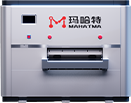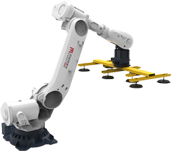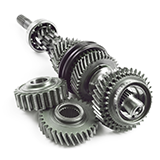What is Laser Cutting?
Laser cutting is a non-contact technology that uses a high-powered laser beam to cut materials with extreme precision. The laser melts, burns, or vaporizes the target material along a predefined path, guided by computer-controlled CNC systems. This process allows for highly accurate cuts, intricate designs, and minimal material wastage.
The technology can be applied to a wide range of materials, including:
Metals (steel, aluminum, copper, titanium)
Plastics and acrylics
Wood and composite materials
Fabrics and leather
The flexibility of laser cutting makes it ideal for both prototyping and mass production, and it is particularly effective in modern production lines that demand speed, precision, and minimal downtime.
Evolution of Laser Cutting Technology
Over the years, laser cutting has evolved significantly, driven by innovations in laser sources, automation, and software control systems. Key developments include:
1. Fiber Laser Cutting
Fiber lasers have emerged as a preferred choice for modern production lines due to their high efficiency, reliability, and ability to cut a variety of metals with superior precision. Compared to traditional CO2 lasers, fiber lasers offer:
Faster cutting speeds
Lower operating costs
Minimal maintenance requirements
High-quality edge finishes
2. Multi-Head Laser Cutting Systems
Multi-head laser cutting systems allow multiple laser beams to operate simultaneously, dramatically increasing throughput. These systems are especially beneficial for high-volume manufacturing, reducing cycle times and ensuring uniform quality across large batches.
3. Automation Integration
Modern laser cutting setups often include automated material handling, such as robotic loading/unloading, conveyor systems, and pallet changers. This integration minimizes manual intervention, reduces errors, and ensures consistent production, making it ideal for mass production and just-in-time manufacturing environments.
4. Advanced Software and CNC Control
Computer-controlled systems have enabled the precise management of cutting paths, speeds, and laser power. Software solutions now support nesting algorithms that optimize material usage and reduce scrap, while real-time monitoring ensures consistent quality.
Benefits of Laser Cutting in Production Lines
The integration of laser cutting into production lines offers numerous advantages over traditional cutting methods:
Precision and Accuracy
A metal laser cutter can achieve tolerances as tight as ±0.1 mm, producing clean edges with minimal burrs. This precision is particularly important in industries such as aerospace, automotive, and electronics, where component accuracy is critical.
Speed and Efficiency
Laser cutting is significantly faster than mechanical cutting, especially for complex shapes or thin metal sheets. Multi-head systems further enhance throughput, allowing manufacturers to meet tight deadlines and high-volume demands.
Material Versatility
Laser cutting is not limited to metals. It can cut plastics, composites, fabrics, and even wood, making it a versatile solution for diversified production lines.
Reduced Waste
Advanced laser cutting services often utilize nesting software to optimize material usage, reducing scrap and lowering production costs. The non-contact nature of the process also minimizes deformation and material damage.
Automation and Flexibility
Modern production lines benefit from automated laser cutting solutions, including robotic integration and CNC-controlled laser heads. This allows for continuous operation, reduced labor costs, and quick adaptation to different product designs.
The Role of Laser Cutting Services
Many manufacturers rely on external laser cutting service providers to access high-quality cutting capabilities without the need for significant capital investment. These services typically offer:
Access to state-of-the-art metal laser cutter equipment
Expertise in handling complex designs and difficult materials
Short turnaround times for prototyping or small-batch production
Consultation on material selection and design optimization
Outsourcing laser cutting service can help manufacturers focus on core production activities while ensuring parts are cut with precision and consistency.
Innovations Driving the Industry
Several recent innovations are shaping the future of laser cutting in production lines:
1. High-Power Fiber Lasers
High-power fiber lasers can cut thicker metals at faster speeds while maintaining edge quality. This advancement allows manufacturers to process heavy-duty materials such as stainless steel and titanium efficiently.
2. 3D Laser Cutting
3D laser cutting technology enables the cutting of non-flat or contoured surfaces, expanding design possibilities for complex components in automotive and aerospace applications.
3. Hybrid Cutting Systems
Hybrid systems combine laser cutting with plasma or waterjet technology to handle diverse materials and thicknesses efficiently. These systems offer the flexibility to switch between cutting modes based on production needs.
4. Intelligent Monitoring Systems
Smart monitoring systems track laser performance, material positioning, and cutting quality in real-time. Predictive maintenance alerts reduce downtime, while quality monitoring ensures consistent output.
5. Integration with Industry 4.0
Laser cutting systems are increasingly integrated into Industry 4.0 smart factories. Connectivity, data analytics, and automation allow manufacturers to optimize production lines, reduce errors, and improve operational efficiency.
Applications of Laser Cutting in Modern Production Lines
The adoption of laser cutting spans multiple industries:
Automotive: Cutting metal body panels, chassis components, and interior parts.
Aerospace: Producing high-precision components from aluminum and titanium alloys.
Electronics: Fabricating enclosures, brackets, and intricate components for devices.
Medical Devices: Manufacturing surgical instruments and medical-grade components.
Metal Fabrication: Producing parts for machinery, construction, and industrial equipment.
A reliable metal laser cutter enables manufacturers to meet stringent tolerances and complex design requirements across these sectors.
Choosing the Right Metal Laser Cutter
Selecting the appropriate metal laser cutter is crucial for maximizing efficiency and output quality. Factors to consider include:
Laser Type: Fiber, CO2, or hybrid lasers depending on material and thickness
Power Rating: Higher wattage for thicker metals or faster cutting speeds
Cutting Area: Sufficient size to accommodate large sheets or parts
Automation Compatibility: Integration with robotic handling or production lines
Maintenance and Support: Availability of service and spare parts
Investing in the right equipment ensures long-term reliability and high-quality output.
Future Trends in Laser Cutting
The future of laser cutting in production lines is promising, with trends such as:
Increased adoption of multi-head systems for higher throughput
AI-driven optimization for cutting paths and material utilization
Expansion of 3D and hybrid cutting capabilities
Integration with IoT-enabled smart manufacturing systems
These innovations will continue to improve efficiency, reduce costs, and expand design possibilities for manufacturers worldwide.
Conclusion
Laser cutting has become a cornerstone of modern production lines, offering precision, speed, and versatility unmatched by traditional cutting methods. Leveraging advanced metal laser cutter technology and professional laser cutting service solutions allows manufacturers to produce high-quality components while optimizing efficiency and reducing waste.
From automotive and aerospace to electronics and general metal fabrication, laser cutting innovations are transforming how production lines operate. By integrating multi-head systems, automation, and smart monitoring, manufacturers can achieve higher throughput, maintain tight tolerances, and stay competitive in today’s demanding industrial landscape.
Investing in the latest laser cutting technology and collaborating with specialized service providers ensures production lines remain flexible, efficient, and capable of meeting future manufacturing challenges.









